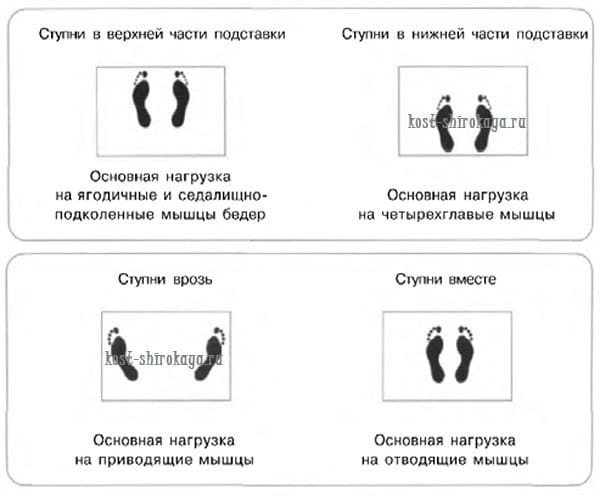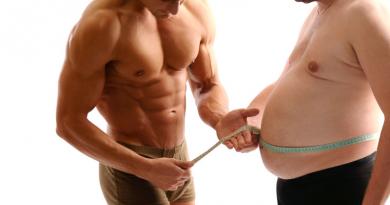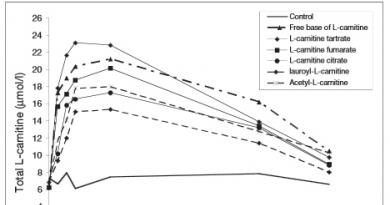Those. multi-joint (hip, knee and ankle joints are involved) exercise for the leg muscles in the simulator at an angle of 45 degrees, which consists of bending and then extending the legs.
Barbell squats or leg press?
There is an opinion that squats can be replaced with leg presses. Many modern trainers give this advice to people with various spinal problems as an alternative to squats. The load on the lumbar spine is supposedly reduced.
Let's start with what it is two completely different exercises. If a person really has some problems with the spine, but he still wants to pump up his legs, then yes, for a while we can replace the squat with a platform press. But first of all, it is still necessary to understand exactly what problems we are talking about.
Attention: our article is not a reason for action or inaction. First of all, your attending physician should explain to you what kind of exercise is contraindicated for you.
When doing a leg press, the load is more targeted on the hip joint, on the area of the sacrum, pelvic bones, and knee joints. We do not stand while performing this exercise, and Stabilizing muscles are not involved in maintaining tone A. Therefore, sometimes the situation can worsen from leg presses, because... engaging the trunk muscles helps strengthen the tone of the lower extremities, thereby minimizing injuries.
Any sane trainer should understand that the minimum load on the spine is in a lying position. In a standing position - the usual load, natural. AND the greatest load on the spine occurs in a sitting position.

When doing exercises while standing, many muscles are involved, including the iliopsum muscles, quadratus lumborum muscles, gluteal muscles, etc. All these muscles help keep the spine in good shape.. When we sit on the exercise machine, we practically turn off these muscles, which means we increase the pressure on the lumbar region. So all this “let’s pump up the butt in the leg press” doesn’t work - the load on them is only to the extent that they have to pervert themselves in order to transfer it there.
Very often, when people perform this exercise, neck gets tired. Everyone knows that the cervical spine is directly connected to the lumbar spine. In this case, do not forget about the cervical-tonic reflex: by throwing our head back, we automatically increase the deflection in the lower back. Thus, the standard recommendation for leg presses is to keep your head flat on the bench. But in this way there will be increased hyperlordosis in the cervical region, and the deflection in the lower back will automatically increase, which means increased pressure on the intervertebral discs. Therefore, this exercise may cause injury.
If place a small cushion under your neck, the spine will take a more natural position, lordosis will decrease, and the load will go away from the lumbar region.

Anyway: If you have problems, it is better to consult a doctor rather than perform exercises by reading an article on the Internet.
Squatting is one of the most natural and daily movements in our lives.. Just imagine: how many times a day do you perform a movement similar to a squat and how many times do you perform a movement similar to a leg press.
The next factor that simply screams loudly that we should make friends with squats is the so-called body’s response to this exercise. The squat, like no other exercise, causes a surge in growth hormone and testosterone, and therefore muscle growth.
Leg press technique:
- “Throw” the required weight from pancakes onto the machine on both sides.
Advice: ALWAYS use the SAME plates in ALL exercise machines so that the load is the same. Those. there is no need to hang 10 kg on one side on the leg press with one plate, and 2 5 kg on the other.
- Take your starting position and place your feet shoulder-width apart in the middle of the platform. Tuck your stomach. Breathe through your chest. Place the center of pressure on the HEELS.
- Leaning against the platform, slightly push it forward with your feet, removing the load from the stoppers. Keep the platform up. Your feet should always be firmly planted on the platform and your heels should not leave the platform throughout the entire set. Hold the handrails firmly with your hands - this makes it easier to maintain a stable body position.
- Slowly lower the “cart” down to a 90-degree angle at the knee joint.
We lower while inhaling. This is a negative phase. In this case, at the lowest point, the angle of flexion in the knee joint should not be less than 90°. Your knees should not touch your chest.
Don't lower the platform any lower- this will force the lower back to tear away from the backrest and take the load, risking injury. Make sure your lower back is always pressed tightly against the bench.
Advice: spend on the negative phase about 3 seconds.Count silently or out loud 1-2-3 as you lower the weight. The key is slow negative movement and powerful positive movement. You will spend 3 seconds lowering, and your thighs will be engorged and groaning from satiety with work, but believe me, this is good stress for the body’s further adaptation.
- Extend your knees, pushing the weight through your heels, then return the platform to the starting position.
We do it while exhaling. This is a positive phase. It should be powerful, fast and confident, but at the same time very smooth. When moving from the bottom point, avoid jerking your body or head.
Advice: Make sure that your knees do not spread out to the sides or press against each other while lifting. Press the platform with your heels (press them forcefully into the platform), but never with your toes.
- At the top do not straighten your legs completely, leave your knees slightly bent. This way we protect our joints and keep the load on our legs throughout the entire set, which is much more effective.
- DO NOT lift your pelvis off the seat, DO NOT bring your knees together, DO NOT straighten them completely, DO NOT lift your heels!
- HOLD THE HANDS WITH YOUR HANDS DURING ALL REPETITIONS
- Repeat the movement as many times as required.
It seems like an easy exercise, but in fact there are many subtleties when performing it.
Leg position for leg press:
As mentioned above, this exercise is very variable and gives scope for those interested. By changing the position of the legs on the platform, we focus the load on different muscle groups.

- feet shoulder width apart- load on quadriceps and hips; the safest option
- feet wider than shoulders, toes pointing out– the load shifts to the adductors, the inner thickness of the thigh is worked out;
- the legs are narrower than the shoulders and located at the bottom of the platform– working out the outer part of the quadriceps; traumatic option;
- feet at the top of the platform, toes slightly turned to the sides– the gluteal and ischial-popliteal muscles of the thigh are loaded; traumatic option;
- single leg press– it all depends on how it is positioned around the perimeter; in the classic version, the entire muscle layer of the leg is worked out.
This option is perfect for girls to create their dream butt. BUT THIS OPTION IS FOR ADVANCED. If you are a newbie, let's pass by.It may seem that there is no difference whether you press with two legs or one. Try it and find out, but believe me, it’s much harder than the classic version! The single leg press is a great way to hit each leg individually and by the way, are you sure your legs are equally strong? The single leg press is a great way to level up your legs, but it also has a high chance of injury!
- Try drop sets.
The idea is that you perform your working weight for a given number of repetitions. Then reduce the working weight and work one more approach without rest. Then reduce the weight again and do another set. Your body will languish in pain, and lactic acid will fill the entire volume of the muscles until you calm down.
- Don't do toe presses!
Although this option is offered as an option for pumping calves, it is very dangerous and harmful to the knees! You never know, you won’t pull the weight and the platform will jump off - brrrr, it’s scary to even think about.
- Take a risk and try the full stop leg press
If you are already an experienced gym goer, then this is probably the most brutal training option for you.
To use this method, you will need a machine that has range of motion limiters to prevent the weight from pinning you down. WE DON'T USUALLY DO IT. Also suitable is a machine in which it is not the weight that moves, but the bench on which you sit.
The main idea is to stop with complete relaxation of the legs.
Step 1. So, first we perform select an average weight for 20 warm-up repetitions. Complete them.
Step 2. Increase the weight. Now you need to do 15 regular reps, then immediately do another 5 reps, but use the full stop technique. Lower the weight all the way, relax your legs for a split second, and then press up explosively.
Step 3. Increase the weight slightly again. Now do 10 regular reps and 10 with a full stop.
Step 4. This is the set after which most people fall off the machine in a practically unconscious state. Add weights again, and do 5 regular reps and 15 with a full stop.
What is different from the classic version: usually you do NOT lower the weight until it touches the stops.
Errors
- Bench press(i.e. you lower the platform down QUICKLY and haphazardly in the style of “just lower it, otherwise I’ll die”).
- Separation of the pelvis from the back
The platform must be lowered to such a level (as you feel, the guideline is 90 degrees) so that the lower back is glued to the back of the machine, otherwise the tube will be injured. Therefore, you need to lower the platform until you feel that you are doing a “safe” bench depth.
A safe depth is when your lower back is pressed tightly against the back of the seat. With excessive heroism, the depth becomes unsafe, i.e. you lower the platform with your legs to such a depth that your lower back is already coming off.
- Bringing the knees inward.
Classic. When you take on too much weight and your legs can’t handle it, your knees start dancing.
This is very, very dangerous, so no records until you are sure of them!
- Separation of the heels from the platform during lowering or during squeezing.
YOU NEED TO LOWER AND SQUEEZE TIGHTLY WITH YOUR ENTIRE FEET (emphasis should be placed on the heels so that if something happens they don’t come off).
Some “experts” deliberately tear off their heels at the top point, as if they also want to shake their shins. No need to do this!

Caution: knees
1. As in squats, in presses you need to watch your knees so that they do not “drive” beyond the line of your toes.
Advice: Place your feet closer to the top edge of the platform. If you place them lower, you are guaranteed to “care” your knees.
2. Place your feet so that you press down on the platform with your heels, not your toes. Otherwise, the knee joints will experience a traumatic load.
3. Do not try to lower the platform as low as possible. At the lowest point, you will inevitably have to tear your pelvis away from the support, and this is a direct threat of injury and subsequent lower back pain.
⛔IMPORTANT: your lower back must be tightly “glued” to the support!
Advice: First, ask someone to watch you. Let him watch the correct technique from the side and indicate to you the safe boundaries of the press.
4. Under no circumstances bend your knees at an angle equal to or greater than 90 degrees. When the legs are bent at an angle of less than 90 degrees, the load puts pressure on the knee joint, and if the angle is more than 90 degrees, it can “tear”. Bringing your knees to your chest is not something you shouldn’t do, but you can’t! If this exercise is performed incorrectly, knees can be injured with relatively light weights.. So watch your technique carefully.
2016-09-27


